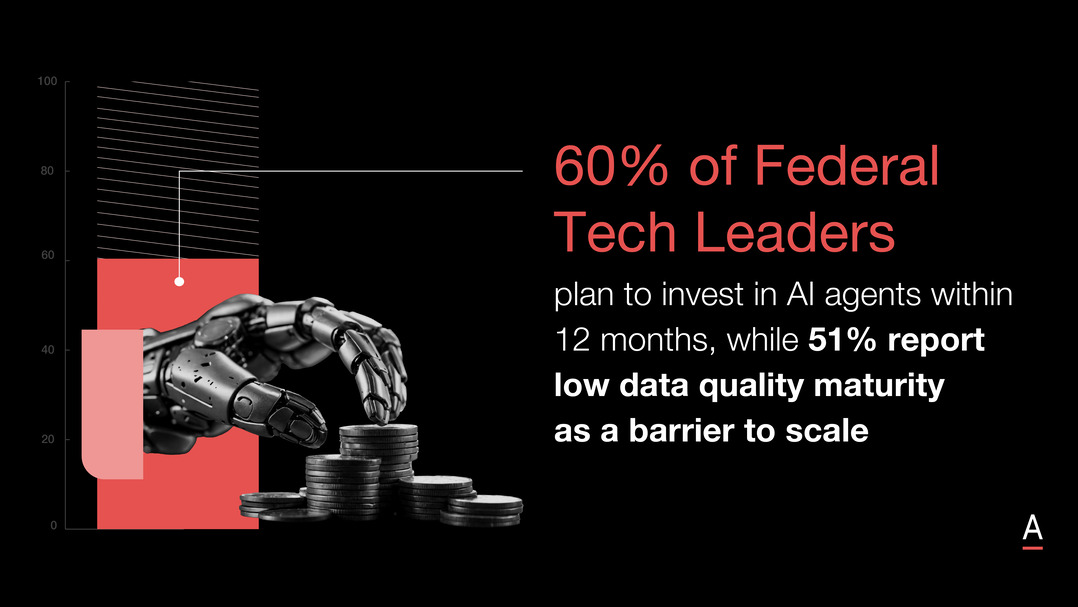4 tech trends defining the future of business in 2025
Discover how data governance, cloud scalability, AI, and cyber security will shape business success in 2025, with key strategies to stay competitive.
2024 has been a transformative year for technology.
Four emerging trends including the adoption of artificial intelligence will shape the future of business and IT as we move into 2025.
Drawing from key data and insights from ADAPT’s Edge surveys and conferences, we explore these pivotal areas that will drive innovation and growth in the coming year.
1. Businesses without mature data governance will fall behind in AI-driven markets
In AI-driven markets, data governance is a strategic advantage.
A structured data management approach helps businesses avoid inefficiencies, inaccurate AI predictions, and flawed decisions while mitigating risks in the volatile AI landscape.
According to ADAPT’s 2024 CIO and Data & AI Edge Surveys, 50% of Australian organisations still report immature data governance, with only 19% demonstrating mature governance practices. This marks a slight improvement, but the challenge remains significant.
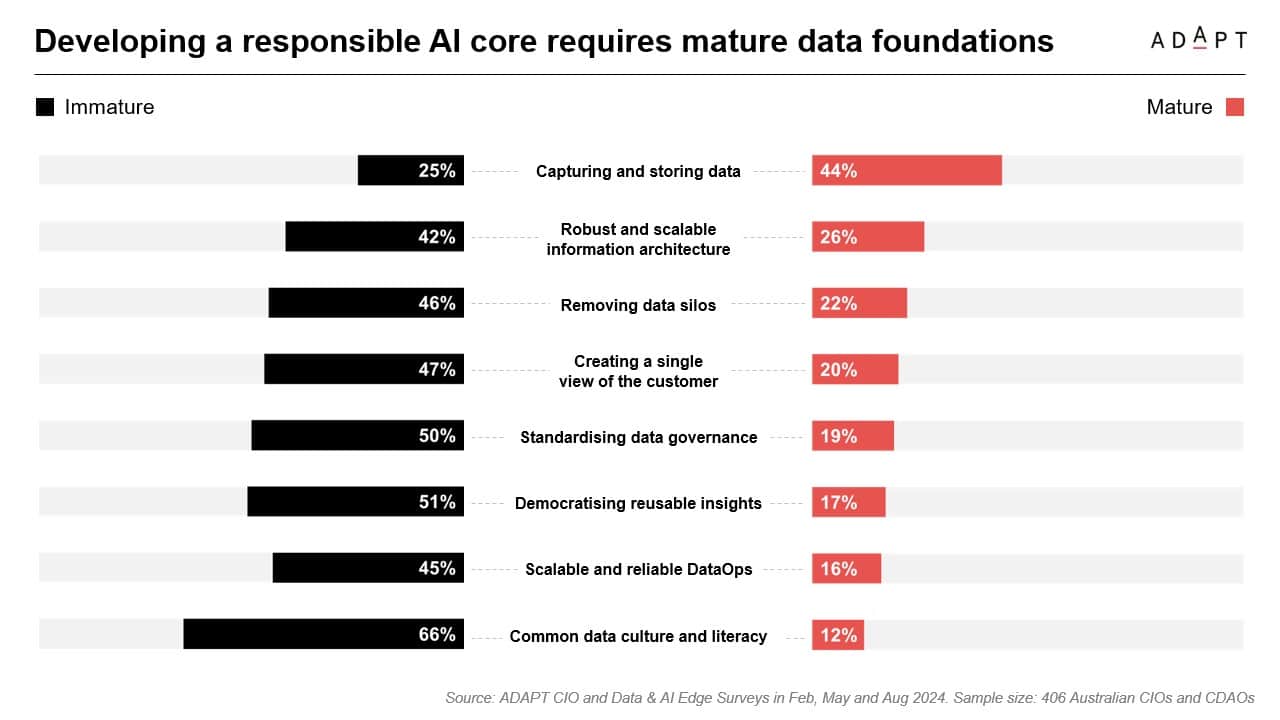
Moreover, only 12% have a fully matured common data culture and literacy, reflecting how foundational data governance structures remain underdeveloped despite AI advancements.
Without mature governance, AI performance is hindered by poor data inputs, as 50% of organisations still struggle to standardise data governance—a critical barrier as organisations scale their AI initiatives.
Organisations with solid governance frameworks, like Scentre Group and SA Power Networks, have demonstrated enhanced operational efficiency through mature data platforms.
These businesses report better AI readiness, as demonstrated by the ADAPT CIO Edge Survey in 2024, where 30% of Australian organisations are now fully prepared to leverage AI technologies, a notable rise from previous years.

For AI to deliver value, organisations must invest in data governance and integrate it deeply into their operations.
According to ADAPT’s 2024 Data & AI Edge Survey, businesses with strong data governance are 4x more likely to be AI-ready compared to those with immature governance practices.
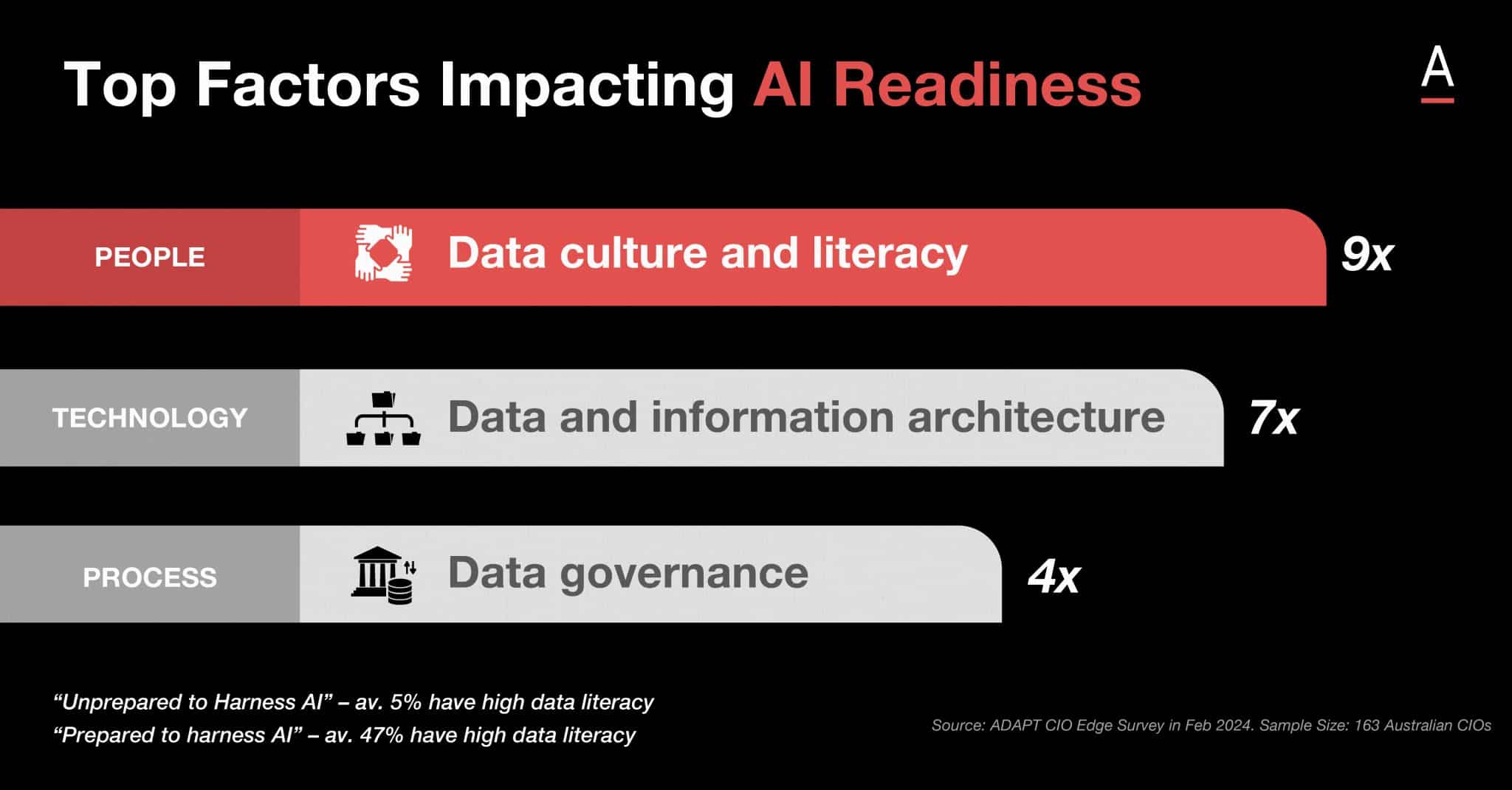
Yet, without a skilled workforce capable of managing data governance effectively, many organisations miss opportunities and remain exposed to regulatory risks.
Ensuring robust data governance becomes critical for both operational efficiency and safeguarding against AI-related risks as AI adoption accelerates.
Organisations slow to integrate AI, particularly without the right data foundations, risk falling behind faster competitors.
AI introduces complexity, increasing the need for stronger cyber security. According to the 2024 ADAPT CIO Edge Survey, 46% of prepared businesses have successfully improved visibility across value chains through effective data governance and AI readiness, compared to 19% of those unprepared.
Stronger defences, particularly in compliance and governance, are essential as AI adoption continues to accelerate.

Without robust governance and the right internal capabilities, organisations risk falling further behind, both in AI performance and regulatory compliance, leaving them vulnerable to competitors and security threats.
2. Australian CISOs will struggle to combat mounting cyber threats as AI amplifies resource shortages
Australian CISOs are under increasing pressure to align cyber security strategies with broader business goals.
In 2024, reliance on AI to mitigate skills shortages has grown, with 72% of CISOs planning or piloting AI initiatives to automate time-consuming tasks, according to an ADAPT Security Edge survey in April 2024.
Despite AI’s potential, many CISOs struggle to balance security investments with business outcomes.
In 2023, only 29% tied their cyber spending to business goals, rising to 49% in 2024, reflecting the growing need to justify security budgets, according to ADAPT Security Edge surveys in April and October 2023 and April 2024 of 244 Australian CISOs.
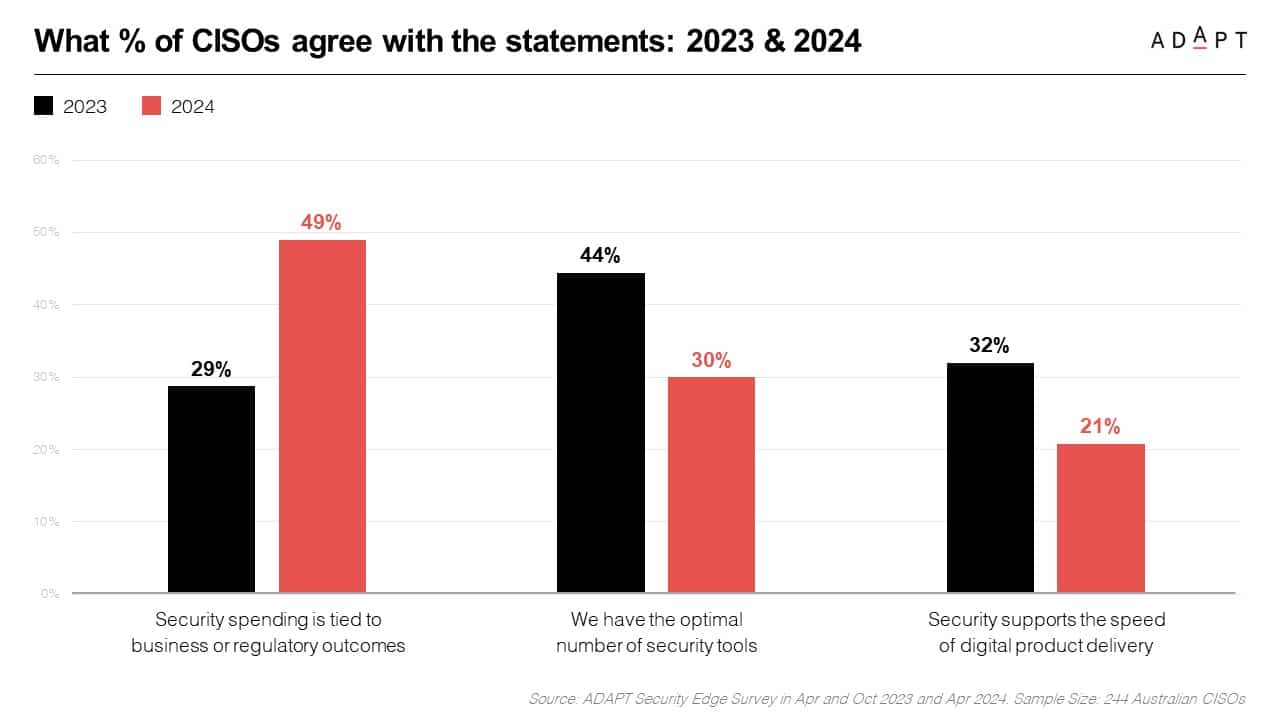
Moreover, in an ADAPT Security Edge survey of 84 Australian CISOs, 66% stated that security leaders still lack the necessary tools and talent to provide world-class cyber protection, compounded by increasing threats and limited executive support, ranked as the second-largest barrier.
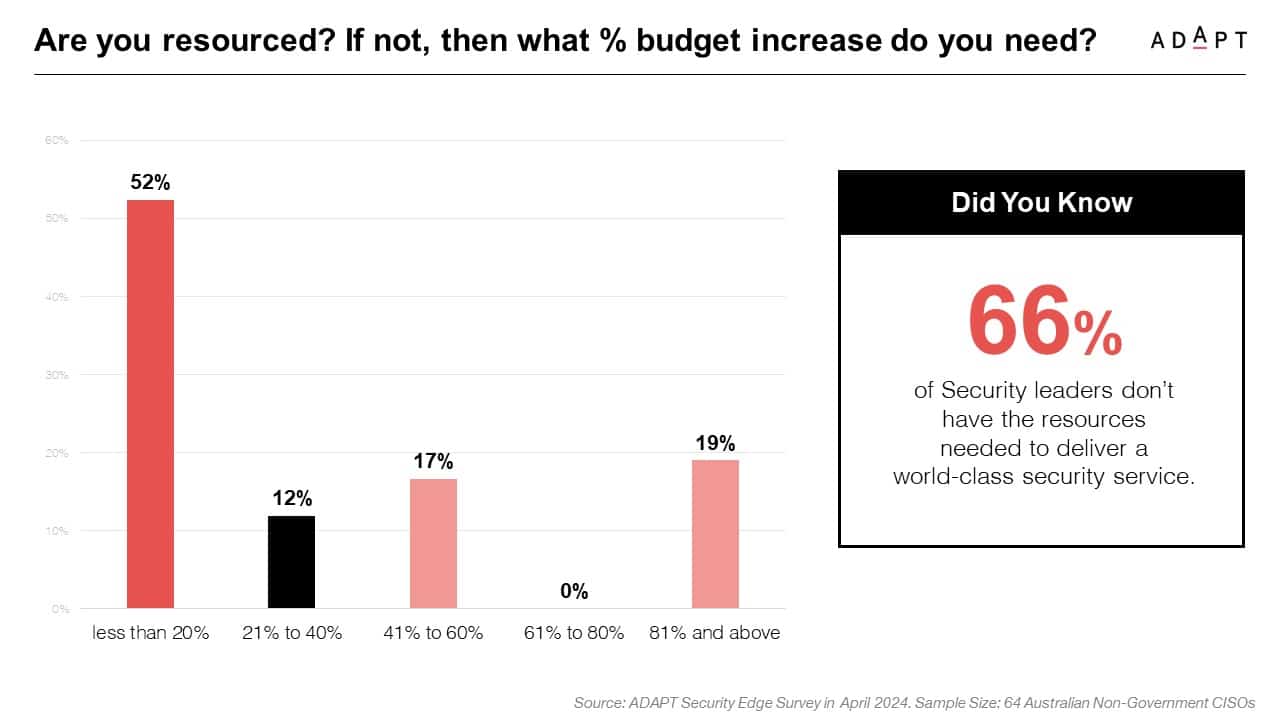
AI deployment brings both opportunities and risks. While AI can streamline operations, it also increases vulnerabilities, particularly with AI-driven cyberattacks.
CISOs face the challenge of safeguarding AI models against evolving threats, prompting 69% to allocate considerable portions of their budgets to cyber awareness and training campaigns to strengthen defences.
This shift shows growing recognition that cyber security is a business-wide issue.
Medibank and Optus have faced major financial and reputational damage from breaches, highlighting the urgency for CISOs to prevent such incidents.
Australia’s cyber security is at a critical point, with AI and quantum computing presenting both risks and opportunities.
Strong frameworks for verification, compliance, and trust are essential as laws evolve.
Many CISOs, burdened by governance tasks, lack the resources for effective strategy execution, with 66% citing limited support and funding.

In the ADAPT CIO Edge Survey from February 2024, 83% of AI-prepared CIOs delivered seamless cyber security, compared to just 58% of those unprepared for AI—further highlighting the link between technological readiness and security success.
As threats escalate, CISOs must take a proactive role in securing their organisations’ future.
3. Misaligned technology ecosystems and AI adoption gaps create barriers to future innovation and sustainability
Australian organisations face a trifecta of challenges: misaligned technology ecosystems, uneven adoption of Generative AI, and the rising pressure to drive sustainability. These challenges risk stalling progress in innovation and long-term environmental goals.
As of 2024, 45% of Australian organisations report effectively capturing customer value, a sharp rise from 22.5% in FY2022-23, underscoring the critical importance of aligning technology investments with business outcomes.
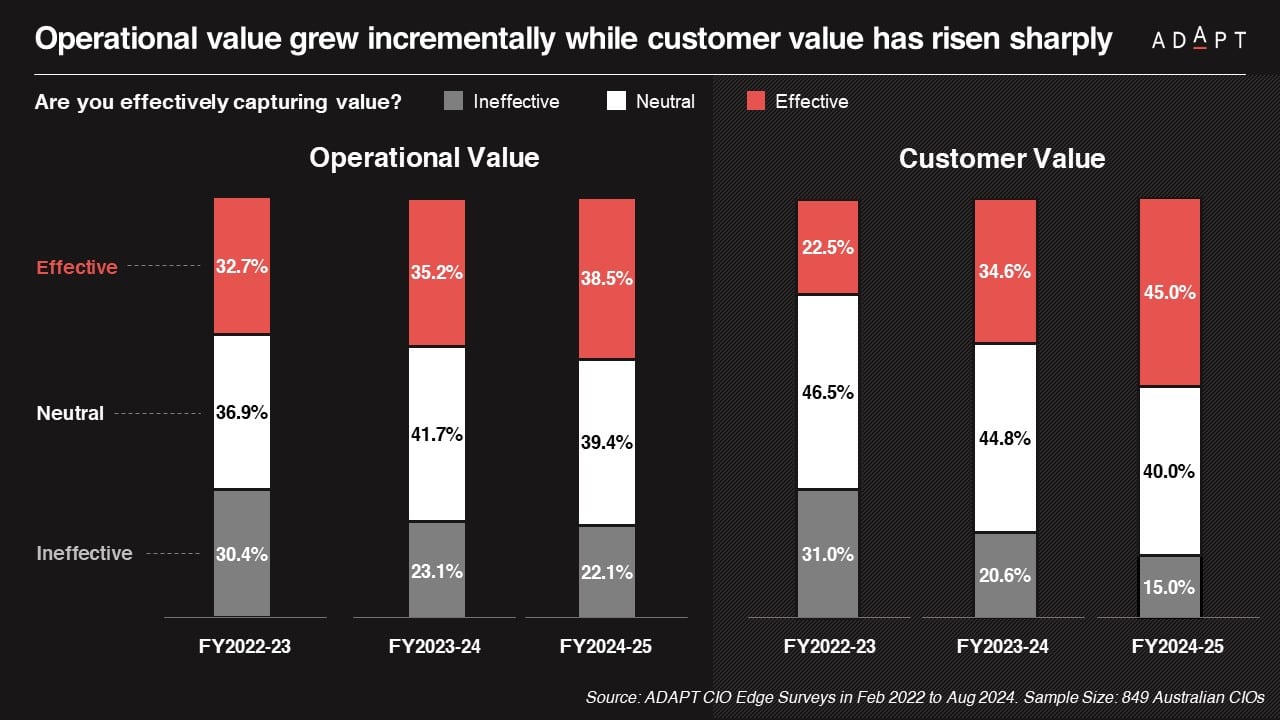
Generative AI is proving to be a powerful tool for streamlining operations, enhancing customer experiences, and driving sustainability.
However, the 2024 ADAPT CIO Edge Survey highlights that Australian organisations still lack a mature data culture, hindering AI-driven innovation and making it harder to capture value and meet innovation and sustainability targets.

To address these gaps, the Australian Government has invested $17 million into AI adoption centres, aiming to help small and medium enterprises (SMEs) bridge this gap and realise the potential of AI for both innovation and sustainable growth.
These centres provide crucial support to ensure AI is leveraged not only for efficiency but also for environmental impact.
As organisations continue to face the dual pressures of innovation and sustainability, overcoming ecosystem misalignments and accelerating AI adoption will be essential.
The shift from project-based to product-based digital delivery, as explored in an ADAPT research, offers a solution.
By focusing on long-term value creation, customer needs, and iterative improvements, organisations can foster greater agility, enhance sustainability efforts, and ultimately drive meaningful innovation.
Delays in addressing these barriers will only widen the gap between early adopters and laggards, as well as between companies able to achieve sustainability goals and those falling behind.
4. Outdated compliance strategies will expose businesses to greater risk in an AI-driven world
Despite increasingly complex digital regulations, many CIOs still do not prioritise governance and compliance.
This gap leaves organisations vulnerable to regulatory penalties as they modernise operations.
Compliance has dropped from #9 in 2019 to #12 in 2024 on CIO priority lists, according to the ADAPT CIO Edge Surveys conducted from 2019 to 2024, which surveyed 1,052 Australian CIOs, despite 47% of transactions now being digital.
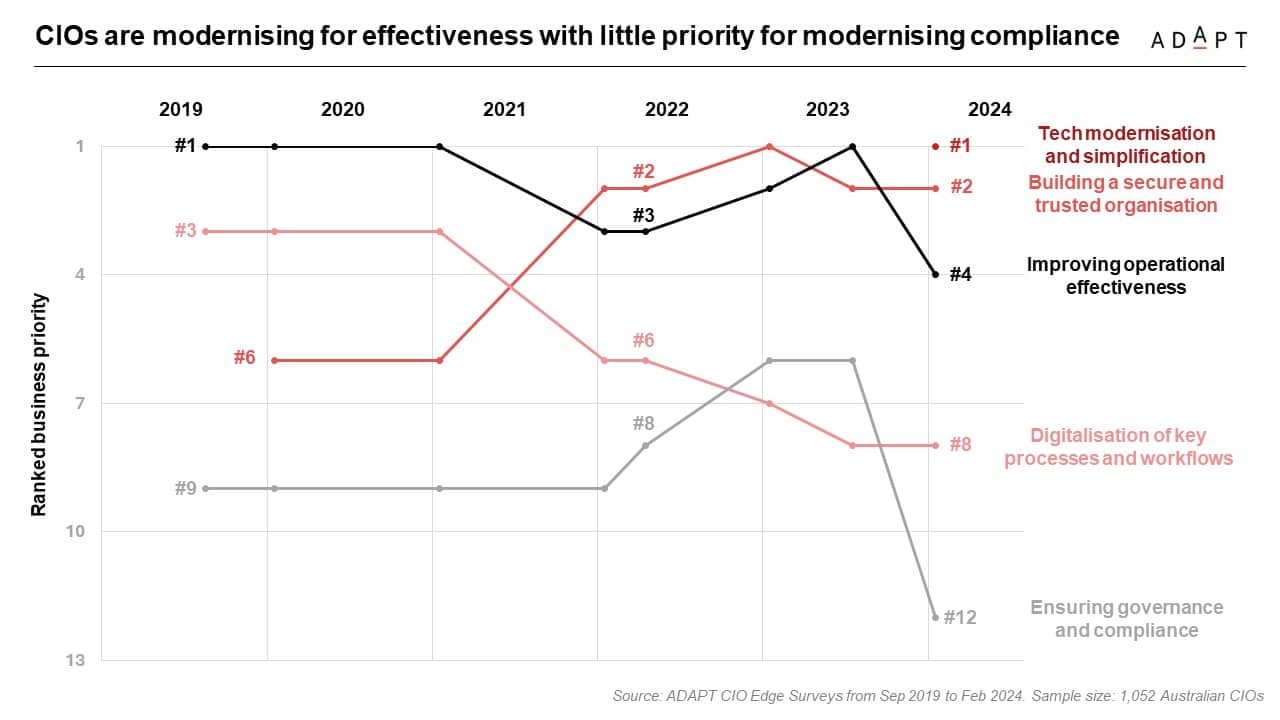
Digital transformation is advancing faster than regulatory frameworks, increasing the risk of non-compliance.
Enabling compliance is still not as seamless as it could be—while 66% of organisations reported seamless compliance in 2024, challenges persist, especially in mitigating third-party risks, where only 35% have streamlined their approach, and 22% continue to find it difficult.
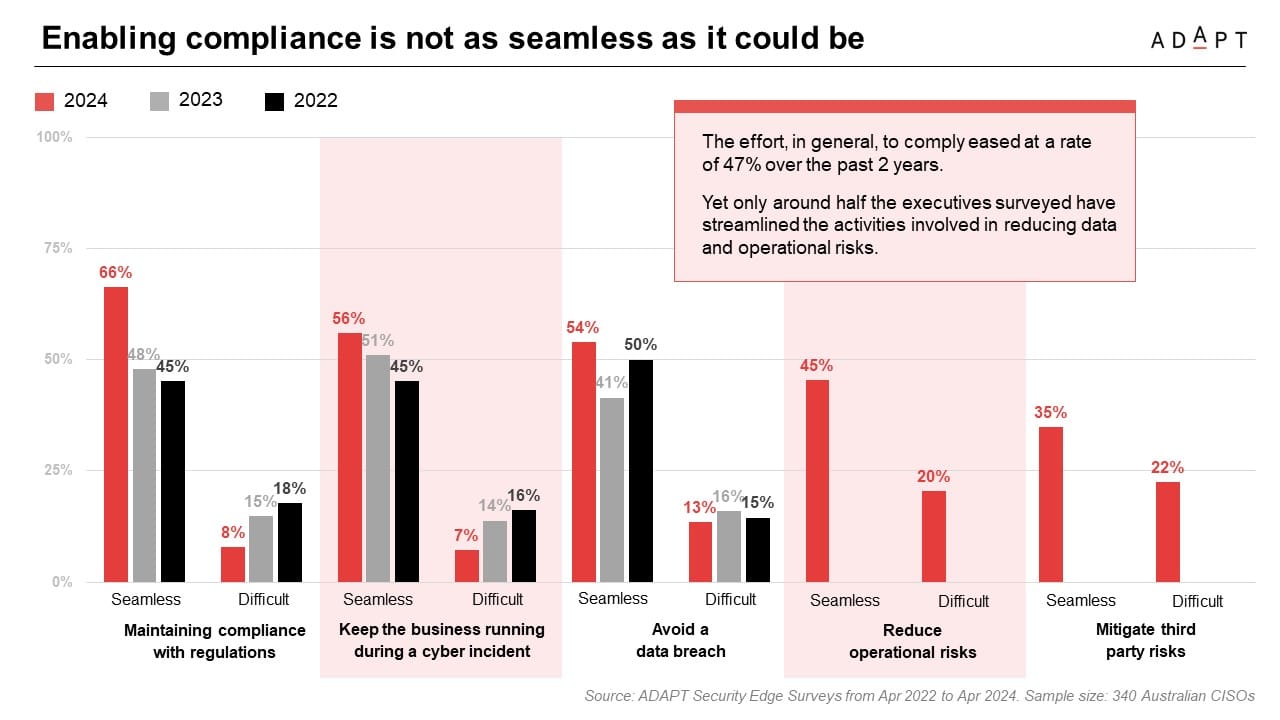
Additionally, only 46% of risk mitigation processes are digitised and streamlined, making it difficult to automate compliance-related functions.
In 2024, 68% of organisations reported seamless compliance while 8% still found it difficult, according to the ADAPT Security Edge Surveys conducted from April 2022 to April 2024, which surveyed 340 Australian CISOs
According to the ADAPT CISO Edge Survey in April 2024, which surveyed 181 Australian executives, privacy remains a critical regulatory concern and is the top priority outlined in the regulatory imperatives for 2024-2025, further complicating compliance efforts.
Weak data foundations exacerbate these challenges, with 51% of organisations struggling to standardise data governance, according to the ADAPT CIO, CISO, and Data & AI Edge Surveys conducted between February and May 2024, which surveyed 395 Australian CIOs, CISOs, and CDAOs.
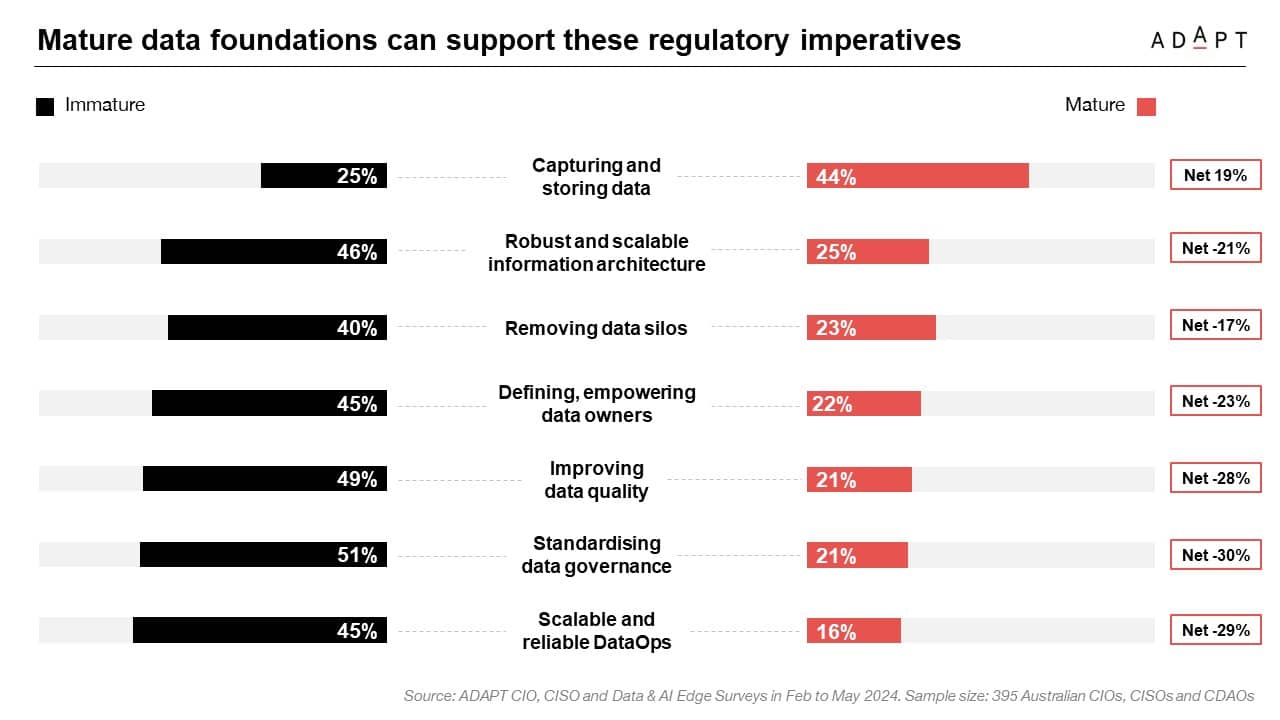
The ADAPT CIO Edge Surveys in February 2024 revealed that 54% of organisations continue to struggle with improving data quality and integration, with only 18% achieving maturity in standardised data governance.
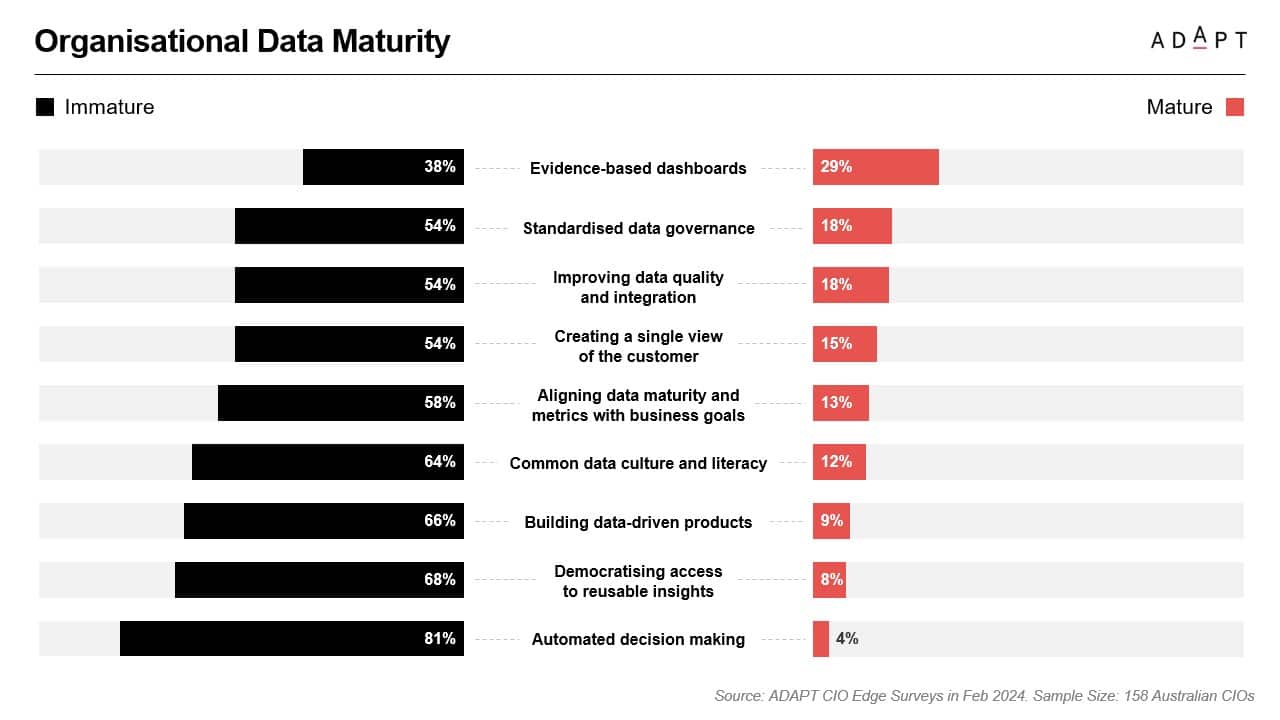
Poor data governance hinders compliance, as regulatory frameworks rely on effective data management.
Leaders at organisations like AMP and Macquarie Group highlights the importance of developing internal capabilities to support cloud and hybrid workloads.

Without the right internal skills, cloud infrastructure costs increase, reducing value.
Executives highlight that developing in-house talent is essential for maximising modernisation efforts and cutting costs by up to half while improving cloud efficiency.
Furthermore, workforce diversity—such as encouraging more women in technology roles, currently only 25% of the sector—enhances innovation and operational outcomes.
An inclusive environment fosters diverse perspectives, driving efficient and creative solutions, particularly in technical and compliance areas.
Without internal capabilities, organisations face higher costs and challenges managing infrastructure, security, and efficiency.
Staff skilled in legacy and modern systems are crucial for cost-efficiency and integrating security into project planning.
56% of CISOs with high cyber resilience agree that security is designed into new systems from the start, compared to 48% with moderate resilience and 27% with low resilience, based on the ADAPT Security Edge Survey from April 2024, which surveyed 82 Australian CISOs.
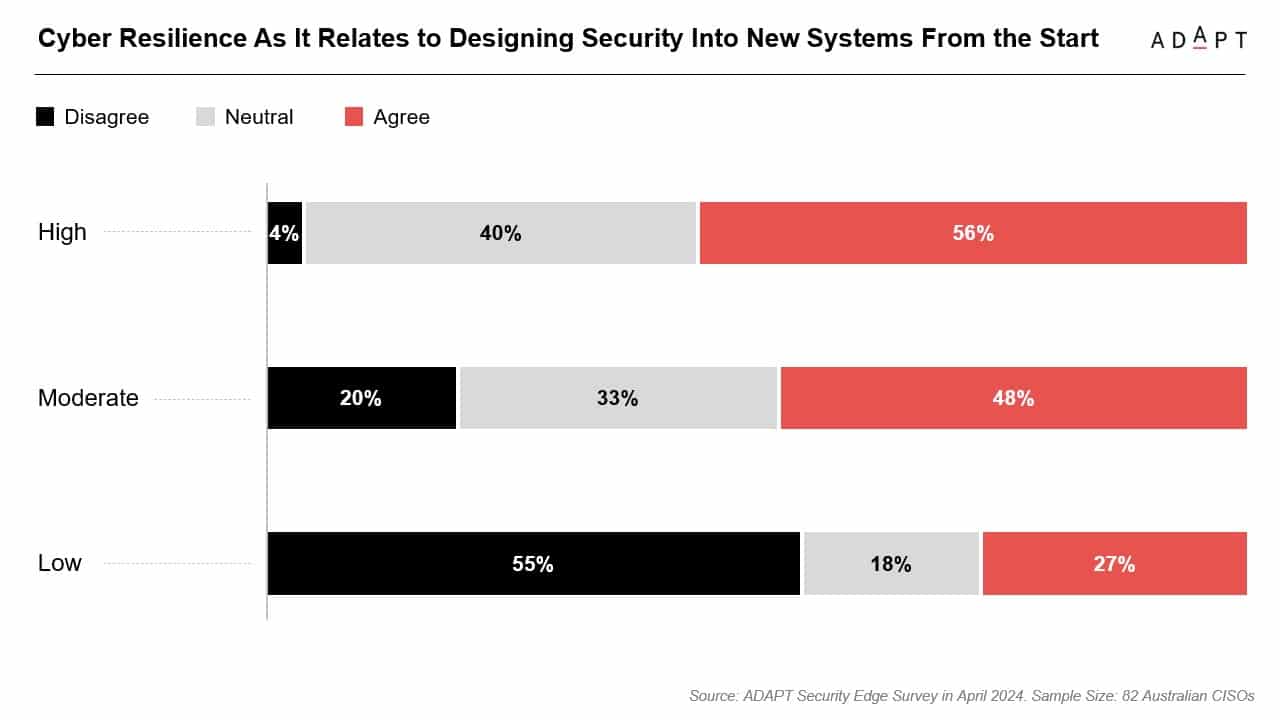
Developing internal talent with security and compliance expertise allows organisations to embed security-by-design early, reducing regulatory risk.
CISOs struggle to justify security investments amid growing regulatory demands for secure-by-design practices
Misaligned security spending and compliance goals increase vulnerability and the risk of penalties.
Edward Santow, Director of Policy and Governance at the University of Technology Sydney, notes that AI’s rapid adoption heightens data privacy and ethics risks, making strong compliance frameworks essential

Aligning security spending with internal capabilities and retaining talent is key to avoiding penalties and ensuring secure digital transformations.
Retaining and developing internal talent is critical for navigating the complex regulatory landscape.
Businesses must ensure they have the right data governance frameworks in place to stay competitive as AI-driven markets evolve.
Success will depend on a strategic overhaul of data management, operational models, and workforce skills to fully leverage the potential of AI technologies.

























